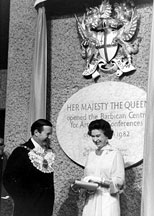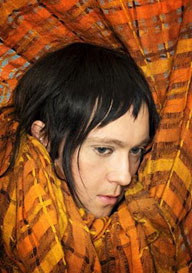|
On Saturday 3 March, the Barbican, one of the world's top arts centres celebrates its 25th birthday, presenting a marathon fortnight of more than 100 events - openings, premieres and family activities.
From Wednesday 21 February, Europe's largest multi-arts centre opens its doors to all with art, film, theatre, dance, education and music activities in every corner of the building.
The Barbican is Europe's largest multi-arts and conference venue, offering  a year-round programme of art, music, film theatre and education. Designed in the 1960s and constructed in the 1970s the Barbican Centre was opened on 3 March 1982 by HM The Queen who described it as 'one of the wonders of the modern world'. Owned, funded and managed by the City of London, the third largest sponsor of the arts in the UK, it was built as 'the City's gift to the nation' at an historical capital cost of £161million, equivalent to almost £400 million today. a year-round programme of art, music, film theatre and education. Designed in the 1960s and constructed in the 1970s the Barbican Centre was opened on 3 March 1982 by HM The Queen who described it as 'one of the wonders of the modern world'. Owned, funded and managed by the City of London, the third largest sponsor of the arts in the UK, it was built as 'the City's gift to the nation' at an historical capital cost of £161million, equivalent to almost £400 million today.
Open 363 days a year, the Barbican presents a uniquely diverse programme of world-class performing and visual arts, encompassing all forms of classical and contemporary music, international theatre and dance, visual arts and design, and a cinema programme which blends first-run films with special themed seasons.
Occupying seven acres, the Barbican site comprises:
- a 1949-seat hall for concerts and conferences
- two theatres: the 1,166-seat Barbican Theatre and the flexible 200-seat Pit
- three cinemas, seating respectively 280, 255 and 153 people
- two art galleries; the 1,393m Barbican Art Gallery and the smaller horseshoe-shaped Curve
- 4,645m of foyers and public spaces
- a lakeside terrace and a rooftop tropical conservatory
- seven conference suites
- two trade exhibition halls
- three restaurants the informal Waterside Cafe, the Balcony Bistro and the more formal Searcy's restaurant
- private function rooms
-The Guildhall School of Music and Drama and the Barbican Library, both under separate management
The Barbican has a history almost as old as London itself. It was first built by the Roman invaders to protect what was for them a new settlement by the river. Within, in the area of the city just south of the Barbican, lived Martin Frobisher, Lancelot Andrews and Thomas More. The area of Cripplegate beyond the wall was in comparison considered to be insalubrious and incommodious. In the 16th century it became the natural home for thieves and receivers of stolen goods. It was a microcosm of Elizabethan 'low life' and became the haven for nonconformists of every description. It was also a home for actors. William Shakespeare lived here at the corner of Monkwell Street and Silver Street. Ben Johnson lived for a period in the Parish of St. Giles. Grub Street was perhaps the most famous of the Barbican streets, and it has remained in the popular imagination ever since it was described by Samuel Johnson as 'much inhabited by writers of small histories, dictionaries and temporary poems.
The Barbican, a populous and ramshackle area, was bound to be a victim of all epidemic disorders that swept across the city. The Great Plague killed some 8,000 out of a population of 11,000 and the Great Fire swept as far north as Smithfield. It slowly grew more ruinous and dilapidated and then in the 20th century was destroyed by German bombs in the Second World War.
By 1951 only 58 people lived in the entire ward. Only in 1952 did plans for redevelopment begin. So the Barbican has been a neighbourhood of actors and of writers as well as the home of vice, disease and fire. It has been an asylum for refugees and outcasts. It has, in a word, been London.
Like the legendary Phoenix, the Barbican rose from the ashes caused by bombing during the Second World War. The idea of the centre was born in the 1960s, an era of renewed optimism and fresh ideas, and an exciting time for the arts. New architectural styles were emerging, including the 'brutalism' that characterises the Barbican as a whole. The concept of the centre grew organically – for example, what was originally intended to be a small recital room evolved into the large Barbican Hall we have today.
The construction did not begin in earnest until 1971. Indeed, it came close to not happening at all. The City of London's Court of Common Council spent its longest sitting on record deciding whether or not to proceed with the project. The architects, Chamberlin, Powell and Bon, were appointed initially to design the residential areas. While they produced an interesting plan, it became apparent that they had never before designed even a cinema, let alone a theatre or concert hall. Their proposals for the cinema included placing the screen on the ceiling and having the first few rows of the audience lying on their backs on what looked like a series of beds. The final cost of building the centre was £156 million; to build it today would require a staggering £500 million.
In the last decade, the Barbican has undergone a radical transformation bringing all the art forms under one roof and finally fulfilling its true potential, to present wide-ranging international programme and multi-arts festivals, which break down the traditional art form boundaries.
The Barbican Centre has scaled new artistic heights under Managing Director Sir John Tusa and Artistic Director Graham Sheffield, and their expert team of programmers and curators.
With the LSO as resident orchestra and BBC Symphony Orchestra as associate orchestra, Great Performers, Barbican Jazz, Mostly Mozart and Only Connect are London's flagship international music series, presenting the full spectrum of classical, contemporary, jazz and world music. The Barbican has forged long-standing partnerships with regularly returning musicians and orchestras: John Adams, Renée Fleming, Cecilia Bartoli, Maxim Vengerov, Steve Reich, Philip Glass, Peter Sellars, William Christie's Les Arts Florissants, the Royal Concertgebouw Orchestra, Herbie Hancock, Sonny Rollins, McCoy Tyner, Wayne Shorter and Wynton Marsalis.
Throughout the year performers, playwrights and companies from around  the world showcase their work to London audiences. Since its inception, bite has commissioned or co-produced more than 50 productions, enabling the creation of new work which might otherwise not have been given a lifeline. In 2004, bite produced its first show The Black Rider, starring Marianne Faithfull and directed by the formidable Robert Wilson with music by Tom Waits. In 2005, bite produced Julius Caesar, starring Ralph Fiennes and directed by theatrical heavyweight Deborah Warner. Its third in-house production is a new family pantomime, the first panto in the Barbican's 25-year history, Dick Whittington & his Cat, which premiered in November 2006. the world showcase their work to London audiences. Since its inception, bite has commissioned or co-produced more than 50 productions, enabling the creation of new work which might otherwise not have been given a lifeline. In 2004, bite produced its first show The Black Rider, starring Marianne Faithfull and directed by the formidable Robert Wilson with music by Tom Waits. In 2005, bite produced Julius Caesar, starring Ralph Fiennes and directed by theatrical heavyweight Deborah Warner. Its third in-house production is a new family pantomime, the first panto in the Barbican's 25-year history, Dick Whittington & his Cat, which premiered in November 2006.
In 1999, under the direction of John Tusa and Graham Sheffield, the visual arts were fully integrated into the Barbican Centre. As well as demonstrating its increasing commitment to contemporary art in the last ten years, Barbican Art Gallery (BAG) has also carved a distinct identity through it's programming of innovative architecture, design and photography exhibitions. 2000 saw the launch of BAG's international touring programme. Today, Barbican exhibitions travel the world, from Beijing to Bristol, Chunking to Chicago, taking a unique range of exhibitions to a global audience. Curve Art was launched in 2006 with a programme of new commissions conceived by international contemporary artists in response to the Curve's distinctive interior, an unusual 100 metre long semicircular space that wraps around the concert hall.
In 1982, cinema operated out of one auditorium – Cinema One – with a small rep programme. 25 years on and audiences can choose between three artistically diverse, international, programmes in three state-of-the-art cinemas. Time Out has described Barbican Film as, "a cinematic treasure trove", whilst BBC Radio 4 Front Row listeners voted it as, "London's most comfortable cinema". From the best in first-run releases, to engaging Barbican Screen Talk interviews, to superlative presentations of live music and silent film, to groundbreaking animation, to life-changing documentaries, Barbican Film is a hotbed of talent, new, old, known and unknown.
Barbican Education thrives to offer powerful learning opportunities that enrich the lives of individuals and widen the access to the artistic programme. A deeper perspective on the arts is achieved through talks, new literary commissions and events that explore the programme through the power of words. Adopt the Barbican was initiated in 1998 in partnership with 15 inner-city schools to bring children together with well known and well loved artists, poets and storytellers. Strong links with four partner youth and community groups have been carefully forged throughout the years to facilitate the delivery of annual arts projects. Thousands of families visit the Barbican to engage in a magnitude of first-hand creative activities and to experience festivals, performances and screenings.
Capitalising on its "all the arts under one roof" advantage, the Barbican has developed a blueprint for ambitious multi-arts festivals, typified by the recent Tropicalia festival which inhabited every corner of the Barbican from art gallery to concert hall, theatre to cinema. The Barbican's enlightened approach to conceptualised, themed festivals, which exploit the potential of the arts centre to the maximum, has become a model much copied around the world.
The Barbican has become a place for realising adventurous and groundbreaking work, challenging and inspiring an audience.
Happy Birthday, Barbican!
|
